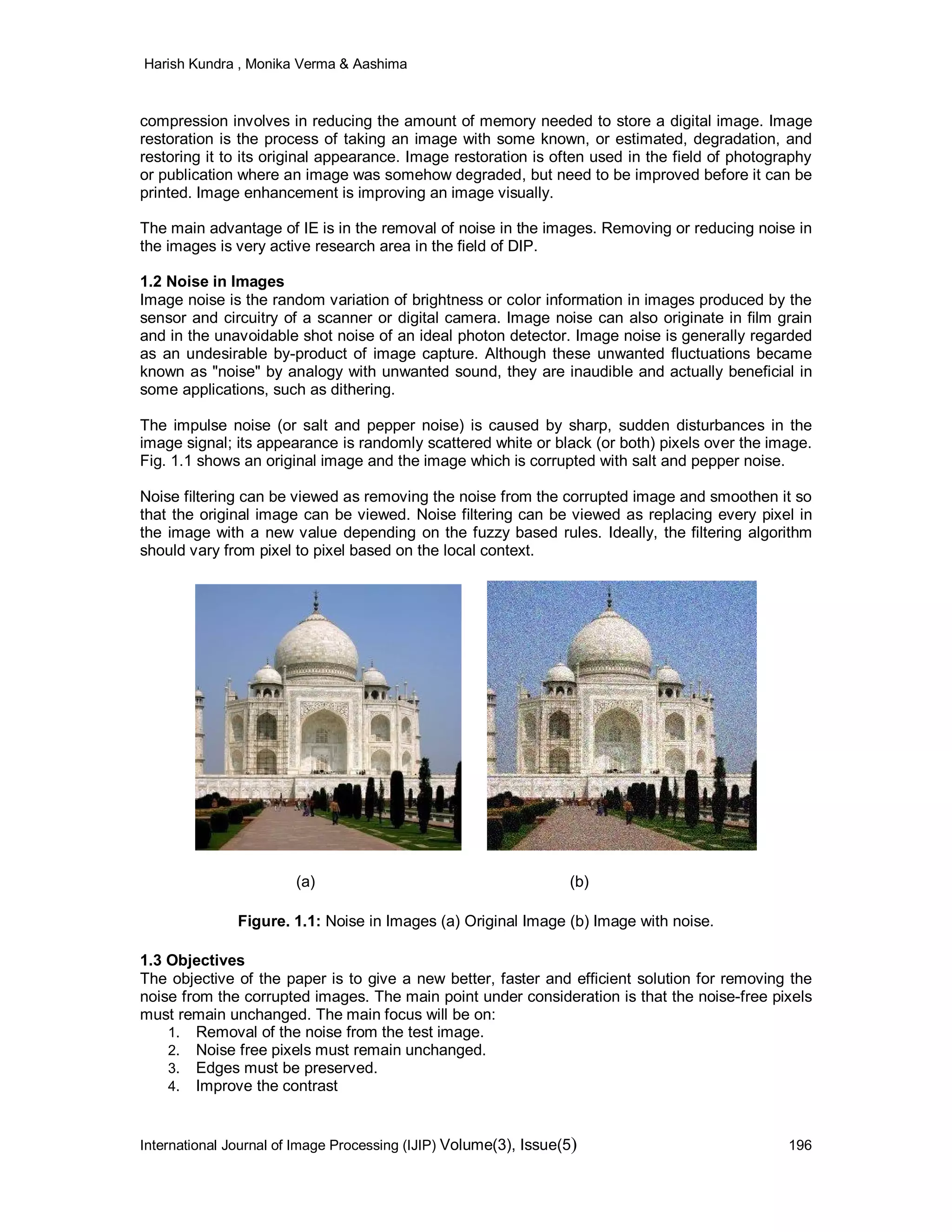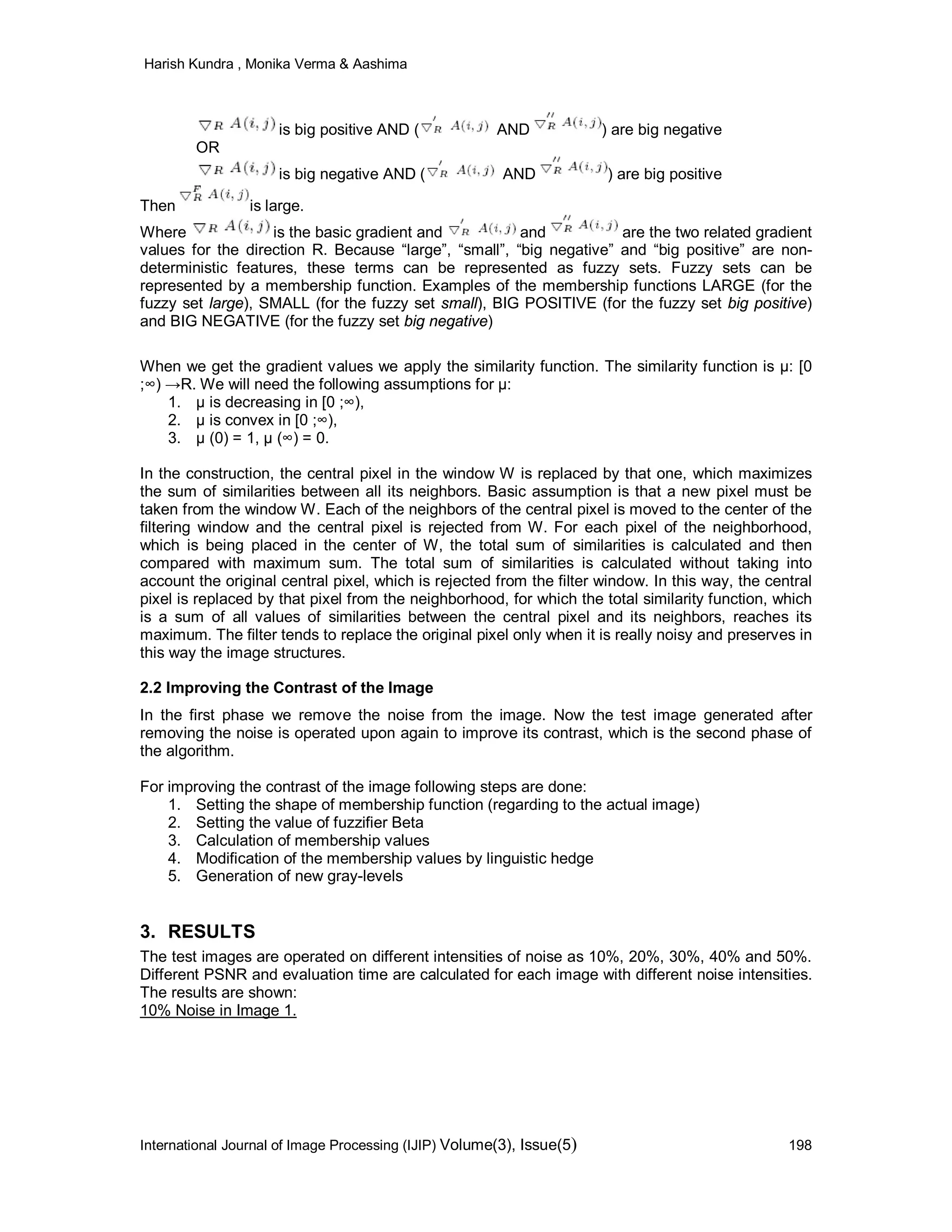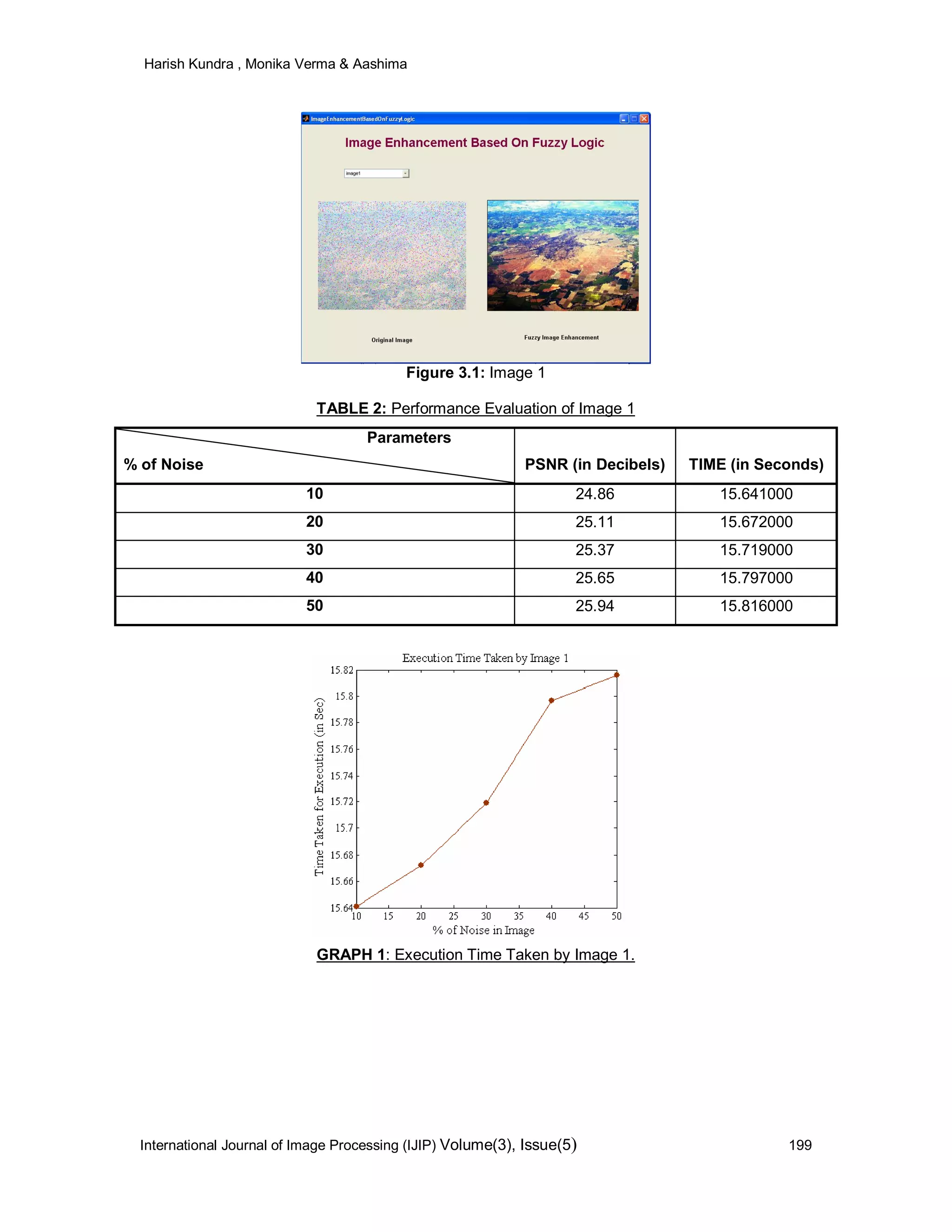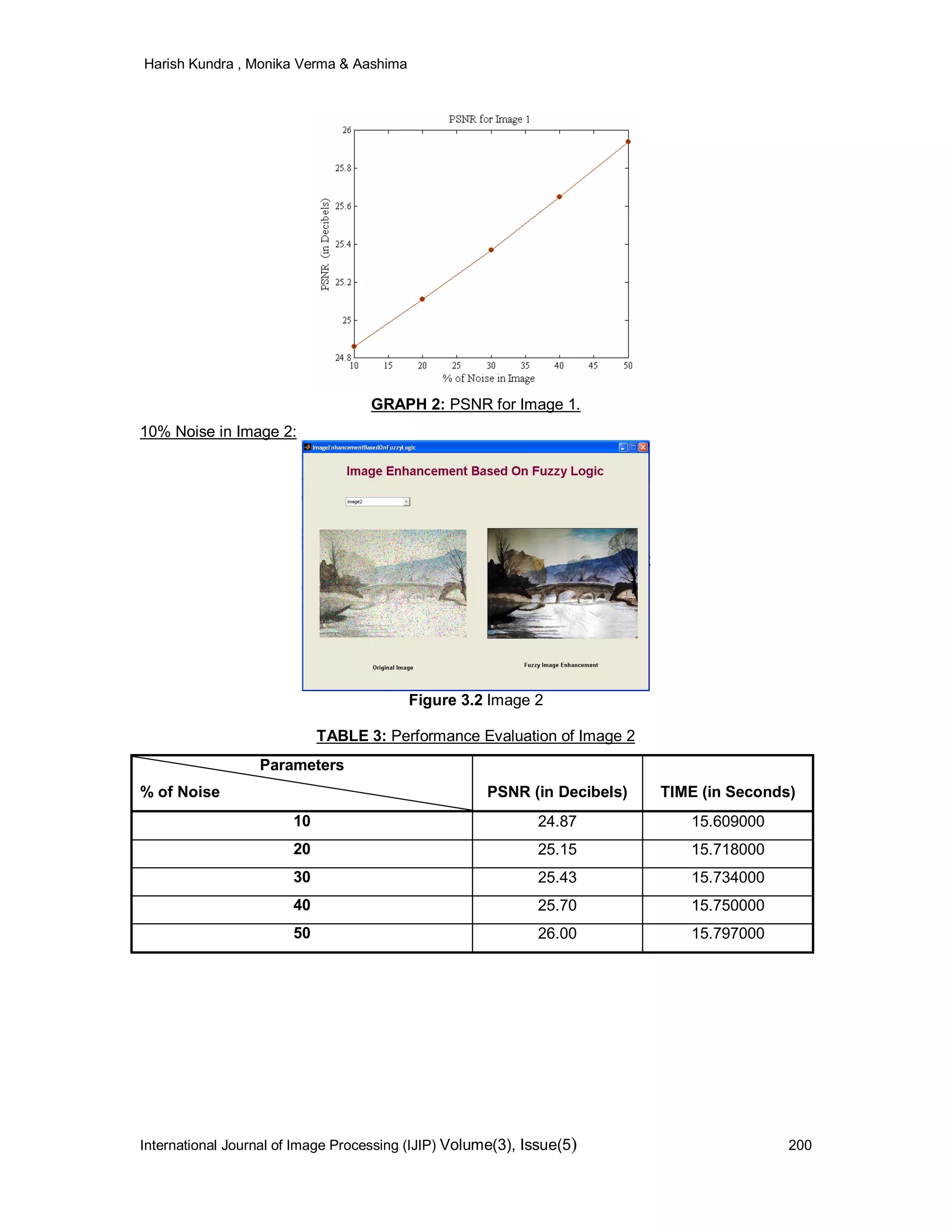The document presents a study on using fuzzy logic for enhancing digital images by effectively removing impulse noise while preserving edge sharpness and improving contrast. It details a proposed filtering method that replaces noisy pixels based on fuzzy inference systems, showing significant improvement over traditional techniques such as mean and median filtering. Results indicate the potential for higher peak signal-to-noise ratios (PSNR) and shorter execution times across varying intensities of noise.
![Harish Kundra , Monika Verma & Aashima
International Journal of Image Processing (IJIP) Volume(3), Issue(5) 195
Filter for Removal of Impulse Noise by Using Fuzzy Logic
Er. Harish Kundra hodcseit@rayatbahra.com
Asistant Professor
R.I.E.I.T., Railmajra
Distt. Ropar, Punjab, India.
Er. Monika Verma monikaverma007@gmail.com
Asistant Professor
S.V.I.E.I.T, Banur
Distt. Patiala, Punjab, India.
Er. Aashima er.aashima@yahoo.co.in
Lecturer
R.B.I.E.B.T., Sahauran
Distt. Kharar, Punjab, India.
Abstract
Digital image processing is a subset of the electronic domain wherein the image
is converted to an array of small integers, called pixels, representing a physical
quantity such as scene radiance, stored in a digital memory, and processed by
computer or other digital hardware. Fuzzy logic represents a good mathematical
framework to deal with uncertainty of information. Fuzzy image processing [4] is
the collection of all approaches that understand, represent and process the
images, their segments and features as fuzzy sets. The representation and
processing depend on the selected fuzzy technique and on the problem to be
solved. This paper combines the features of Image Enhancement and fuzzy
logic. This research problem deals with Fuzzy inference system (FIS) which help
to take the decision about the pixels of the image under consideration. This
paper focuses on the removal of the impulse noise with the preservation of edge
sharpness and image details along with improving the contrast of the images
which is considered as the one of the most difficult tasks in image processing.
Keywords: Digital Image Processing (DIP), Image Enhancement (IE), Fuzzy Logic (FL), Peak-signal-to-
noise-ratio (PSNR).
1. INTRODUCTION
1.1 Image Processing
An image is digitized to convert it to a form which can be stored in a computer memory or on
some form of storage media such as hard disk or CD-ROM. This digitization procedure can be
done by scanner, or by video camera connected to frame grabber board in computer. Once the
image has been digitized, it can be operated upon by various image processing operations.
Image processing operations [1] can be roughly divided into three major categories, Image
Compression, Image Enhancement and Restoration and Measurement Extraction. Image](https://image.slidesharecdn.com/ijip68-160216123913/75/Filter-for-Removal-of-Impulse-Noise-By-Using-Fuzzy-Logic-1-2048.jpg)

![Harish Kundra , Monika Verma & Aashima
International Journal of Image Processing (IJIP) Volume(3), Issue(5) 197
2. PROPOSED WORK
In literature several (fuzzy and non-fuzzy) filters have been studied [2] [3] [5] [6] for impulse noise
reduction. These techniques are often complementary to existing techniques and can contribute
to the development of better and robust methods. Impulse noise is caused by errors in the data
transmission generated in noisy sensors or communication channels, or by errors during the data
capture from digital cameras. Noise is usually quantified by the percentage of pixels which are
corrupted. Removing impulsive noise while preserving the edges and image details is the difficult
issue.
Traditionally, IE techniques such as mean and median filtering have been employed in various
applications in the past and are still being used. Although these techniques remove the impulsive
noise but they were unable to preserve the sharpness of the edges. They smooth the noise as
well as the edge sharpness. They were unable to improve the contrast of the image. A fuzzy
theory based IE avoids these problems and is a better method than the traditional methods. The
proposed filter provides an alternative approach in which the noise of colored image is removed
and the contrast is improved.
To achieve a good performance, a noise reduction algorithm should adapt itself to the spatial
context. Noise smoothing and edge enhancement are inherently conflicting processes, since
smoothing a region might destroy an edge, while sharpening edges might lead to unnecessary
noise. Many techniques to overcome these problems have been proposed in literature. In this
thesis a new filter, based on the concepts of IE and FL have been introduced that not only
smooth the noise but also preserves the edges and improve its contrast. The test images taken
into consideration have impulse noise or salt and pepper noise.
The work is done in two phases. In the first phase, the noise in the images is removed and in the
second phase, contrast is improved. The output image generated is noise-free high-contrast
image.
The noise intensity in the same test image varies as 10%, 20%, 30%, 40% and 50%. For each
case the PSNR and Execution time is calculated.
2.1 Phase 1: Removal of Impulsive Noise
For each pixel (i, j) of the image (that isn’t a border pixel) we use a 3×3 neighborhood window.
For each pixel position we have the gradient values. The two related gradient values for the pixel
in each direction are given by the following table:
TABLE 1. Basic and two related gradient values for each direction.
These values indicate in which degree the central pixel can be seen as an impulse noise pixel.
The fuzzy gradient value for direction R (R є {NW, N, NE, E, SE, S, SW, W}), is
calculated by the following fuzzy rule:
If | | is large AND | | is small
OR
| | is large AND | | is small
OR](https://image.slidesharecdn.com/ijip68-160216123913/75/Filter-for-Removal-of-Impulse-Noise-By-Using-Fuzzy-Logic-3-2048.jpg)



![Harish Kundra , Monika Verma & Aashima
International Journal of Image Processing (IJIP) Volume(3), Issue(5) 201
GRAPH 3: Execution Time Taken by Image 2.
GRAPH 4: PSNR for Image 2.
4. CONSLUSION & FUTURE WORK
Various test images of different extensions are fed to the system. The images are corrupted with
salt and pepper noise as well as are of low contrast. The filter is seen to preserve intricate
features of the image while removing heavy impulse noise where as the conventional mean and
median filters fail in this context even at low corruption levels. The learning of fuzzy rules in a
fuzzy image filter with a true hierarchical fuzzy logic structure where the output of the first layer is
fed in to the second layer to obtain an ‘improved’ final output. The evaluation parameters PSNR
and Evaluation time taken are evaluated. The program generates positive PSNR and is above
20dB which is considered to be the best ratio. The overall execution time which the program
takes is approximately 15 seconds.
In future, modification of fuzzy rules can produce better result. Other techniques such as PSO
can also be used for image enhancement.
5. REFERENCES
[1] Gonzalez, R.C., Woods, R.E., Book on “Digital Image Processing”, 2nd
Ed, Prentice-Hall of
India Pvt. Ltd.
[2] Carl Steven Rapp, “Image Processing and Image Enhancement”, Texas, 1996.
[3] R. Vorobel, "Contrast Enhancement of Remotely-Sensed Images," in 6th Int.
Conf. Math. Methods in Electromagnetic Theory, Lviv, Ukraine, Sept 1996, pp.
472-475.](https://image.slidesharecdn.com/ijip68-160216123913/75/Filter-for-Removal-of-Impulse-Noise-By-Using-Fuzzy-Logic-7-2048.jpg)
![Harish Kundra , Monika Verma & Aashima
International Journal of Image Processing (IJIP) Volume(3), Issue(5) 202
[4] Tizhoosh, “Fuzzy Image Processing”, © Copyright Springer, 1997.
[5] Farzam Farbiz, Mohammad Bager Menhaj, Seyed A. Motamedi, and Martin T. Hagan, “A new
Fuzzy Logic Filter for image Enhancement” IEEE Transactions on Systems, Man, And
Cybernetics—Part B: Cybernetics, Vol. 30, No. 1, February 2000
[6] P. Fridman, "Radio Astronomy Image Enhancement in the Presence of Phase Errors using
Genetic Algorithms," in Int. Conf. on Image Process., Thessaloniki, Greece, Oct 2001, pp. 612-
615.](https://image.slidesharecdn.com/ijip68-160216123913/75/Filter-for-Removal-of-Impulse-Noise-By-Using-Fuzzy-Logic-8-2048.jpg)